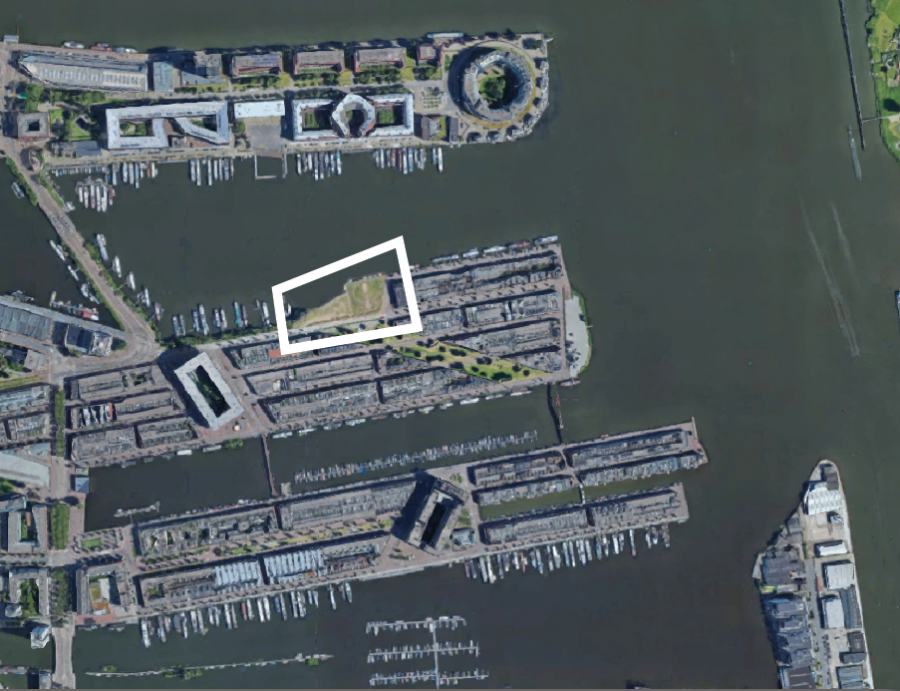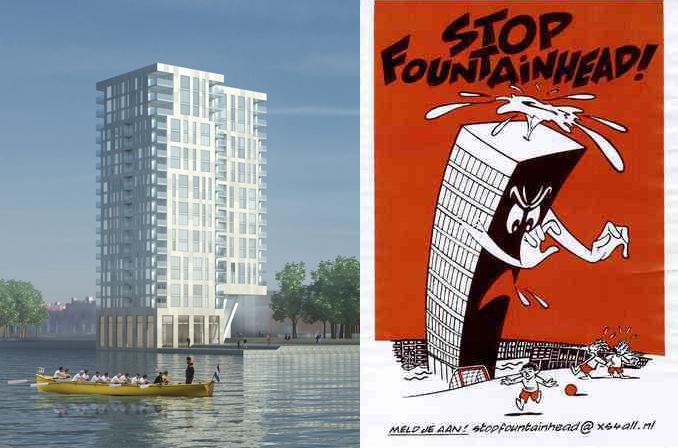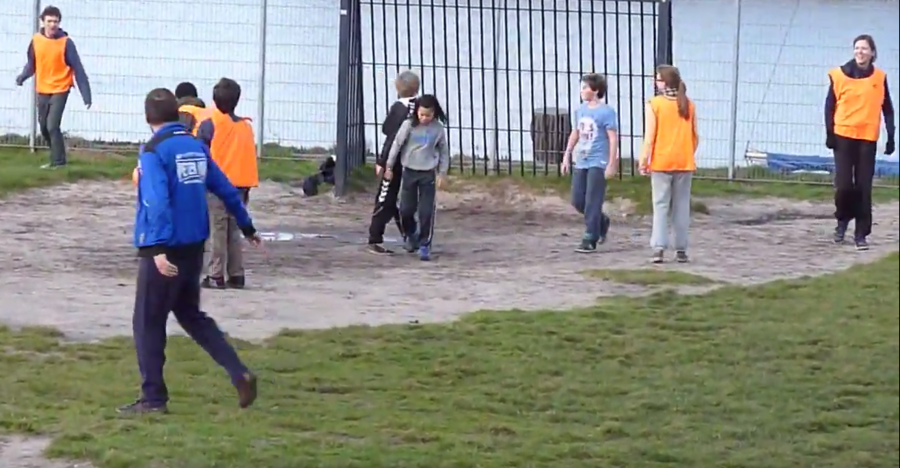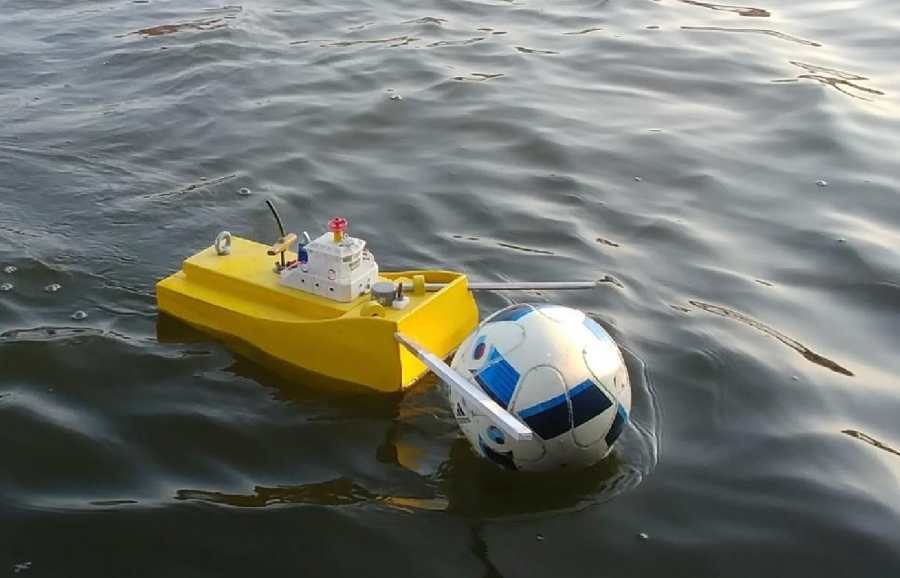
Het Trapveldje: Vacant space in the densely built environment
Het Trapveldje was a space for wild play and ‘marginal’ activities, where locals came to play, linger, talk and watch. This indistinct, scruffy field was also a stage for an unyielding battle between locals and the municipality of Amsterdam.
Vacant space, densification and the quality of life
In a survey conducted in my neighbourhood, the assumption was made that a high level of public space maintenance by the municipal government is what citizens want. The survey was commissioned by the municipality of Amsterdam and will be used as a reference tool for policy to improve citizens' quality of life (Gemeente Amsterdam, 2019). This is a generally shared belief, as many cities have "Clean It or Lien It" regulations in order to prevent a shabby appearance due to weedy vegetation or trash accumulation on vacant properties (Corbin, 2003). Vacant properties, as described by Corbin, do not seem to have a place in the Amsterdam municipality's frame of reference. Yet, these unordered vacant spaces are sometimes a part of local life, people use them to socialize, play and organize events.
This article provides a brief overview of perceptions of vacant space in the build environment. Generally, vacant spaces are considered to diminish property value and to discourage investment, further it is believed that they increase crime (Mallach, 2006). These perceptions are mostly developed in the context of decline and de-urbanization. After reviewing the policy reports about extensive densification of the city of Amsterdam, it seemed appropriate to investigate the role of empty space in the context of a densely built environment.
For this, Het Trapveldje and its bearing in the Eastern Harbour District (Oostelijk Havengebied) in Amsterdam are used as a case study. Both citizens and the municipality were deeply involved with this vacant lot. It seems to have a different kind of meaning than the vacant spaces discussed in a context of decline. How was Het Trapveldje used? Did the ‘vacantness’ of the site or the ‘denseness’ of the neighbourhood contribute to its meaning? The more encompassing question is: What is the purpose of empty or vacant space in the context of the ‘compact city’?
For years, Het Trapveldje was the last vacant space in the neighbourhood. Situated near the waterfront, it was destined to become the building site for Fountainhead, a luxury high rise building. After delays due to the internet crisis in 2002 and the economic crisis in 2008 and a lengthy struggle with local activists, plans for Fountainhead seemed to become obsolete (Zonneveld, 2010). Het Trapveldje was saved from eradication for more than a decade. In 2016, supported by accelerating economic growth, construction work started for a high rise building named Steltloper. It ended the existence of a flourishing vacant space.
Vacant spaces and the broken window theory
Vacant and abandoned spaces are considered a problem by municipal officials in large cities (Accordino & Johnson, 2000). Weedy courtyards, broken windows, potholes, ruptured fences, and empty spaces in the urban context are usually understood as human failure (Corbin, 2003). A derelict environment implies social decay (Jakle & Wilson, 1992). “Abandoned houses and apartments can become hangouts for thieves, drug dealers, and prostitutes” (Spelman, 1993, p.481). Vacant properties “do serious harm to their communities” (Mallach, 2006, p. ix). “They signify the ills of neglect” (Jakle & Wilson, 1992, p.175).
These disturbing words are bolstered by the influential "broken window" theory, which states that neglect in a city environment, however small it might be, can cause serious crimes. In 1969 Stanford psychologist Philip Zimbardo arranged to have an automobile with its hood up and without license plates parked in the Bronx. Within ten minutes the car was stripped of its radiator and battery, windows were smashed, the car was severely damaged and everything of value was removed within twenty-four hours (Wilson & Kelling, 1982). Less attention was given to the episode in which children started to use the car as playground. The simple conclusion was “that disorder needs to be taken seriously” and “broken windows do need to be repaired quickly” (Skogan, 1992, p.75).
It may not seem surprising that many cities promote a policy of high level maintenance to cultivate an ordered appearance and give evidence of care (Corbin, 2003). Cities all over the world have initiated multivarious strategies which aim to improve the public space “to enhance cities' attractiveness and competitiveness”. (De Jong, Schraven, Zhan, & Weijnen, 2015, p. 25). Abandonment and vacancy are simply stages on the road to renewal (Bowman, 2004, p. 4). Besides, for municipalities unproductive land is missed tax revenue (Goldstein, Jensen & Reiskin, 2001), which results in fewer resources for the community.
These conceptions of empty and vacant urban spaces and the need for order and care are developed in the context of cities or neighbourhoods that have experienced population loss and economic decline, a multifaceted phenomenon conceptualized as 'urban shrinking' (Bernt, 2016). The backdrop of this article is my own neighbourhood, the Eastern Harbour District. The district has had some of these issues in the past, it is however in no way a 'shrinking city'. The former harbour district was built with the concept of the 'compact city': high-density housing with an average of approximately 40 houses on one acre (100 homes per hectare). Roughly 18,500 residents live in the area, a number that has been stable over the recent years (Gemeente Amsterdam, 2018).
Clean and tidy
In the policy report Amsterdam Heel & Schoon, the city announced an investment in a major proactive maintenance strategy. "Whereas the city is now moderately kept clean, we are from now on going to keep it meticulously clean and tidy" (Gemeente Amsterdam, 2017). With the Amsterdam Heel & Schoon report, the policymakers issued a considerable increase in initiatives aimed at regulating the cityscape.
A similar attitude is found in the document Structuurvisie Amsterdam 2040, the terms 'densifying' the city or 'densification' are used sixty-five times, indicating the desire to optimise land use within the inner-city. The document expresses what the city should look like in 2040. It aims to accommodate the growth of the population and tourism. Proposals are being made to transform vacant and undeveloped areas into more intensively used areas (Gemeente Amsterdam, 2011). Empty spaces, sometimes referred to as 'missing teeth' (McGrath, 1989) are not considered a part of the 2040 cityscape.
Joan Nassauer discusses the urban landscape in terms of care and neatness. She states, along with various other urban researchers, that the appearance of the landscape has an effect on feelings of safety and neighborliness among residents (Nassauer, Raskin, 2014). However she warns against the darkside of care: “Neatness is a powerful landscape label. It can say care without meaning care . . . we can be fooled by neatness" (Nassauer, 1988, p. 975).
Care can be nurturing, yet it can also be an expression of dominance. It communicates the intention of the caretaker, it envelopes, for instance, a message of control or an expression of disdain for imperfection (1988). The city of Amsterdam stipulates that cleanliness is the basic condition for a sustainable and pleasant public space (Gemeente Amsterdam, 2017). This raises the following question: does this tenacious choice for neatness reveal a true concern for citizens' well being, or does it conceal a darker intention of control?

The compact city model: The Eastern Harbour District
The Eastern Harbour District consists of several artificial peninsulas, named Java eiland, KNSM eiland, Oostelijke handelskade, Sporenburg, Borneo eiland and Cruquius eiland. It was constructed in the beginning of 1900 to accommodate large sea-going vessels. Here, cargo and passengers arrived from and departed to the former Dutch Indies, Africa, and the Americas. After a progressive start things quickly began to unravel. Air travel, decolonization, and a lack of growth potential eradicated the economic prospects of the Eastern Harbour District. In the late 1970s and early 80s, the municipal government decided to designate the islands as a residential zone.
While the city planners were planning, the islands were taken by artists, squatters and houseboat people. Over a period of two decades the neighbourhood changed drastically from a brownfield area to a densely built district with 8000 dwellings in 2003. Where possible the existing and squatted harbour buildings were legalised and reconstructed (Buurman, Hulsman, Ibelings, Jolles, Melet & Schaap, 2007), consequently squatters stayed, became ex-squatters and started families. The functional housing and contemporary aesthetics attracted well-off creatives with home based businesses and young families (Kloosterman, 2012). A new community of creatives shaped a free spirited local culture of pioneerism.
The Eastern Harbour District is “an example of the official translation of the compact-city thinking” (Buurman et al, 2007, p. 27). The city planners decided no gardens were needed, because the presence of massive volumes of water would compensate for the lack of greenery (Buurman et al, 2007). The neighbourhood is praised for its architectural and urban planning quality. Renowned Dutch and international architects, notable projects and rigorous urban planning made the area a hotspot for architecture tourists (Buurman et al, 2007).
For me as a resident, the main attraction is still the massive water basins surrounding the islands. In the summertime the neighbourhood transforms in an open air swimming pool, people walk the streets in their bathing suits, wet towels cover the pavements and quays, rafts are build and children jump off of the high (thirty feet) red bridge. The municipality points out the risks, and swimming in open water is forbidden, bridge jumping even more so (Remie, 2015). Occasionally the bridge jumpers are warned, but as a rule these laws are not enforced. A similar approach is applied to the land grabbing locals. Architectural historian and critic Hans Ibelings observes: A “slow motion green guerrilla warfare has been waged for years, in which the residents are trying to take over the streets bit by bit” (Buurman et al, 2007, p. 125).
Het Trapveldje, a place for social interaction and a symbol of rebellion
Although it did not look very significant, Het Trapveldje was the scene of regular social gatherings. It was considered the last vacant lot for freeplay, a playground for everyone. People came to talk, celebrate birthday parties, walk their dogs, linger, set up protest camps, watch and play a game of football. When the municipality revealed building plans for this lot, the neighbourhood arose in defense of this last unfilled empty space.
The official designated future of Het Trapveldje was contested by a good deal of the locals. The local activist group called Stop Fountainhead, started a blog on the 5th of April 2005. The demands and objections voiced on the blog indicate a high level of expertise and knowledge; local architects, lawyers and house owners joined forces to stop the building plans. The lengthy and purposeful protests did command respect and attracted the attention of the local newspaper (Stop Fountainhead, 2005).
The objections raised against the drafted design plan included the quality of air and wind hindrance, the undemocratic planning process, the overly high building density created by this new building, and the loss of the informal grassroots playground, Het Trapveldje.

Left: Design drawing of Steltloper [detail] (Bouwadviesbureau IGG, n.d.). Right: Stop Foutainhead poster (International Intitute of Social History, n.d.)
Many researchers have described the importance of open spaces in an urban environment. Furthermore the perception of ownership is described as an important aspect of how people experience space. Some open spaces are perceived as belonging and being freely accessible to everyone (Woolley, 2003). The open spaces that are described as vacant space have often an additional feature: an unintentional and uncontrolled quality.
Het Trapveldje could be identified as such a space. These kind of sites do not frequently arouse feelings of historic prominence. These spaces are not ‘built’, they are not impressive and do not attract tourists. Still vacant spaces are sometimes used and valued by locals, they may have meanings that have no physical presence (Corbin, 2003). Het Trapveldje had many meanings; for some locals it was a place for leisure and social interaction, for some a symbol of the rebellion against the perfection of an urban plan without space for free play.
Although such spaces do not seem to have historic distinction, they sometimes are imbued with local memory. Vacant spaces like Het Trapveldje can create cultural life and thus can be considered local cultural heritage. The Faro Convention (2005) proclaimed “the need to put people and human values at the centre of an enlarged and cross-disciplinary concept of cultural heritage” and “the need to involve everyone in society in the ongoing process of defining and managing cultural heritage”. This seems to support an open attitude towards countercultural heritage.
The Stop Fountainhead blog was used to raise money for the lawsuits against the municipality and to give and share information about the future of Het Trapveldje. What also was shared on the blog was what happened on a daily base at Het Trapveldje: “Every day I see swarms of children play football. Every day teams are formed spontaneously by children and adults of all kinds of nationalities” (Stopfountainhead, 2005).

Zondagvoetbal
One of my neighbours described the origin of a gathering on Het Trapveldje: “In the beginning we just played football with a small group of friends and family, after a while people started to ask if they could join in. During my daily trips to the grocery store children approached me to inquire about the next game. Some of these children proved to be very good players, so our games became quite interesting and we started to play regularly” (personal communication, April 8, 2019).
Zondagvoetbal evolved into a game with a name, a set of rules, and special equipment. Played by an all age and gender group: (4 to 64 years) the game could last one hour or the whole Sunday afternoon. The team that scored the tenth goal was the winner of the day. Most of the games ended in 9-10, because newly arrived players were allocated to the losing team. On sunny days teams of fifteen or more players were common. Sometimes it was so crowded that new arriving players had to wait until someone left to enter the game. Training vests became part of the routine equipment as well as the 'ballenboot', a specially built remote-controlled boat to collect the balls from the water.

On rainy days some of the players came early to check the field. It was not maintained by the municipality, so large puddles with water needed attention. Holes were punched in the soil and drain systems were developed to dry the field. Sometimes a birthday party was going on, or another group was playing. A process of collective bargaining and negotiations was then conducted. My nextdoor neighbour, also a regular player, described the negotiations as being firm as well as flexible. “Usually, the other group decided to join our game” (personal communication, April 8, 2019).
Play and shaping a community
Zondagvoetbal was one of the community originated projects that existed on Het Trapveldje. One could describe many more. Projects in which the local community worked together to have fun, convey local expertise and knowledge, and enhance quality of daily life. None of these events had a major physical presence and Het Trapveldje was not prominent or a feast for the eyes. Nevertheless, it had meaning in the community of the densely built Eastern Harbour District.
Het Trapveldje did foster one of the main goals (1a) articulated in the municipalities program for 2019 - 2022: A strong network ensures that local residents experience more social cohesion, it encourages citizens to support and reinforce one another more often. The neighbourhood will benefit from joint thinking and joint actions. Collectively organised activities create mutual cohesion and reduces segregation and feelings of insecurity (Gemeente Amsterdam, 2018).
The policy of densification as it is promulgated by the city of Amsterdam may serve many goals: it will most likely accommodate more people and more businesses, and eliminate the need to disrupt the landscape surrounding the city. Still, it could be argued that the city of Amsterdam needs to acknowledge the value of unordered and uncontrolled space in densely built neigbourhoods.
Awareness of the value of such spaces has been unceasingly present amongst citizens. Yet, the municipality of Amsterdam does not seem to recognize the potentiality of spaces like Het Trapveldje. The aim of this paper is not to demonstrate a conflict between citizens and the municipality; there will always be citizens who are happy with government policy and those who are not. For instance, one can imagine that the families now living in Steltloper are content with the decision to build on Het trapveldje.
The issue is that the municipality dismisses the value of unordered spaces like Het Trapveldje by institutionalising a decree of orderly neatness. The general idea that citizens quality of life is raised by the cleanness of the city and not by unordered spaces for wild play is clearly articulated in the policy reports Amsterdam Heel & Schoon and Structuurvisie Amsterdam 2040, and also in the survey about citizens' well being commisioned by the municipality .
In its efforts to manage the compact city, the municipality seems to cling to ideas that emanated from ‘shrinking cities’ and the broken window theory: tying disorder to crime. By doing so, the municipality neglects to contemplate the value of unordered spaces in the 'compact city', and at the same time effectively silences a voice that would have been able to formulate an answer to the question of the purpose of empty or vacant space in the ‘compact city’.
Ideas aired in the policy reports counteract the ability of citizens to shape their neighbourhood. Maybe it is time for the municipality of Amsterdam to, once in a while, moderate their impulses to control the public space and leave some space for the citizens to play and shape community life, and in the process improve the quality of city life.
References
Accordino, J. & Johnson, G. (2000). Addressing the vacant and abandoned property problem. Journal of Urban Affairs 22(3), 301-315.
Bernt, M. (2016), The Limits of Shrinkage: Conceptual Pitfalls and Alternatives in the Discussion of Urban Population Loss. International Journal of Urban and Regional Research, 40(2), 441-450. Retrieved April 5, 2019, from doi:10.1111/1468-2427.12289
Blankert, T. (2016) Zondagvoetbal [Photograph].
Blankert, T. (2016) Ballenboot [Photograph].
Bouwadviesbureau IGG. (n.d.). De Steltloper [Photograph]. Retrieved April 15, 2019, from https://www.igg.nl/projecten/de-steltloper/
Bowman, A. (2004). Terra incognita: Vacant land and urban strategies. Washington: Georgetown University Press.
Buurman, M., Hulsman, B., Ibelings, H., Jolles, A., Melet, E., & Schaap, T. (2007). Eastern Harbour District Amsterdam: Urbanism and Architecture. Rotterdam: NAi Publisher.
Corbin, C. (2003). Vacancy and the landscape: Cultural context and design response. Landscape Journal, 22(1), 12-24.
De Jong, M., Joss, S., Schraven, D., Zhan, C., & Weijnen, M. (2015). Sustainable–smart–resilient–low carbon–eco–knowledge cities; making sense of a multitude of concepts promoting sustainable urbanization. Journal of Cleaner production, 109, 25-38.
Faro Convention. (2005, 27 oktober). Council of Europe Framework Convention on the Value of Cultural Heritage for Society. Geraadpleegd op 13 april 2019, van https://www.coe.int/en/web/conventions/full-list/-/conventions/treaty/199
Gemeente Amsterdam. (2011, February 17) Structuurvisie Amsterdam 2040 Economisch sterk en duurzaam. Retrieved April 10, 2019, from https://131f4363709c46b89a6ba5bc764b38b9.objectstore.eu/hior/Documenten/Structuurvisie%20Amsterdam%202040%20(2011).pdf
Gemeente Amsterdam. (2017, June 8). Amsterdam Heel en Schoon. Retrieved April 7, 2019, from https://www.amsterdam.nl/bestuur-organisatie/volg-beleid/afval-en-schoon/
Gemeente Amsterdam. (2018). Gebiedsplan Oostelijk Havengebied 2019. Retrieved April 10, 2019, from https://www.amsterdam.nl/bestuur-organisatie/volg-beleid/gebiedsgericht/...
Gemeente Amsterdam. (2019, March 14). Bewoners over hun buurt in Oost 2019. Retrieved April 5, 2019, from https://www.amsterdam.nl/onderzoek/oost/
Goldstein, J., Jensen, M., & Reiskin, E. (2001). Urban vacant land redevelopment: Challenges and progress. Cambridge, MA: Lincoln Institute of Land Policy.
International Institute for Social History. (n.d.). Stop Fountainhead poster [Photograph]. Retrieved April 15, 2019, from https://search.iisg.amsterdam/Record/1299205
Jakle, J. A., & Wilson, D. (1992). Derelict landscapes: The wasting of America's built environment. Lanham, MD: Rowman & Littlefield Publishers.
Kloosterman, R. (2012). Planning for creativity: the transformation of the Amsterdam Eastern Docklands. New Urbanism: Life, Work, and Space in the New Downtown, 61-85.
McGrath, B. (1989). Prototypical Solutions In C. Willis and R. Genevro, (Eds.) Vacant Lot (p. 19). New York: Princeton Architectural Press
Mallach, A. (2006). Bringing buildings back: From abandoned properties to community assets: A guidebook for policymakers and practitioners. New Brunswick, NJ: Rutgers University Press.
Nassauer, J. (1988). The aesthetics of horticulture: neatness as a form of care. American Society for Horticultural Science, 23(6), 973 - 977.
Nassauer J., Raskin, J. (2014). Urban vacancy and land use legacies: A frontier for urban ecological research, design, and planning. Landscape and Urban Planning, 125, 245-253, https://doi.org/10.1016/j.landurbplan.2013.10.008.
Remie, M. (2015a, August 7). Een beetje vies, maar wel lekker. NRC. Retrieved April 8, 2019, from https://www.nrc.nl/nieuws/2015/08/07/een-beetje-vies-maar-wel-lekker-1524103-a266333
Skogan, W. (1992). Disorder and decline: Crime and the spiral of decay in American neighborhoods. Berkeley, C: University of California Press.
Spelman, W. (1993). Abandoned buildings: magnets for crime? Journal of Criminal Justice 21(5) 481-495.
Stop Fountainhead. (2005, April 5). Integratie [Blog post]. Retrieved April 5, 2019, from http://stopfountainhead.blogspot.com
Wilson, J., & Kelling, G. (1982). Broken windows. Atlantic monthly, 249(3), 29-38.
Woerden, F. (2016, May 23). Trapveldje, Eastern Harbour District [Photograph]. Retrieved April 14, 2019, from https://www.skyscrapercity.com/showthread.php?p=131143572
Woolley, H. (2003). Urban open spaces. London: Taylor & Francis Group.
Zonneveld, J. (2010, May 20). Fountainhead komt er vooralsnog niet. Het Parool. Retrieved April 13, 2019, from https://www.parool.nl/parool/nl/6/WONEN/article/detail/295318/2010/05/20/Fountainhead-komt-er-vooralsnog-niet.dhtml